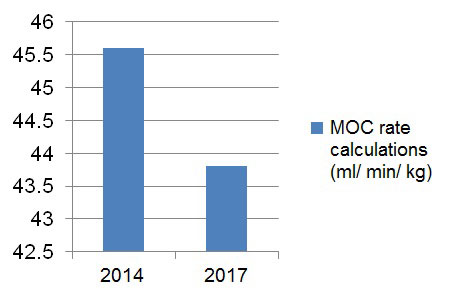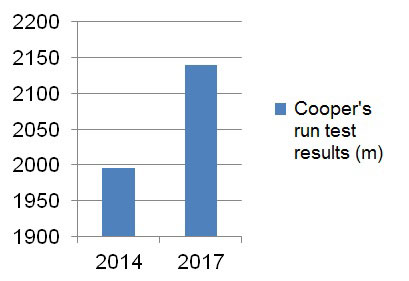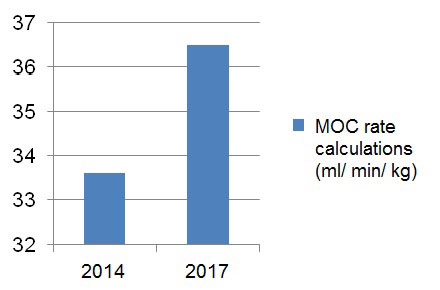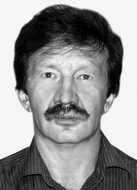Maximal oxygen consumption rates in students' physical health tests and analyses
Фотографии:
ˑ:
R.F. Tazetdinov1
G.G. Tazetdinova1
PhD, Associate Professor N.A. Krasulina1
PhD, Associate Professor A.V. Greb1
1Ufa State Petroleum Technological University, Ufa
Keywords: physical education, sports, MOC, CVS, students, Cooper’s 12-minute run test, cyclic sport disciplines.
Introduction. Nowadays, there is a tendency towards a quantitative approach to health assessment. According to N.M. Ammosov, the "amount" of health is determined by the total reserve capacity of the oxygen transport system, which, in turn, is determined by the maximal oxygen consumption. Aerobic load constitutes an overwhelmingly large proportion (>90%) of daily load [1, 2]. The main numerical criterion of aerobic capacities is considered to be the MOC rate per 1 min. Depending on the MOC rate in untrained people, we singled out 5 levels of physical condition: very high, high, average, low, very low [3, 8].
It is a scientific fact that physical education is the most important factor in determining the life expectancy rate in man, barring his age. It was considerably more significant than such traditionally considered factors as smoking, heart disease, diabetes, high blood pressure and cholesterol.
Such physical exercises as walking, running (3 hours a week) lead to an increase in the MOC rate by 10-15% as early as at the 10th-12th weeks. Over the course of 3 months, MOC can increase by 10-15%, in 6 months - by 20-25%, in 12-24 months - by 30-40%. In other words, most of the body adaptation resource can be utilized within two years (V.N. Platonov, 2001).
A decrease in the MOC rate by 1 MET (3.5 ml/ kg/ min) reduces the probability of living in the next decade by 12% [6].
Objective of the study was to analyze the students’ physical condition on the basis of the maximum oxygen consumption rate and to develop practical recommendations on their motor mode optimization.
Methods and structure of the study. In 2014-2017, an experiment was conducted in the male (n=559) and female (n=494) training groups with a total of 1053 students of all faculties of USPTU involved in the study. In the 1st and 6th semesters, we applied the Cooper’s run tests to obtain the MOC rates in all groups (7 faculties), the 1st semester versus the 6th one, according to the formula: ml/min/kg = (distance, m)-505)/45.
Results and discussion. Based on the Cooper’s run test results, we calculated the MOC rate for 3 years by the indirect method according to the formula: MOC ml/min/kg = (distance (m)-505)/45 [8]. Based on the results of the study conducted at all USPTU faculties (Cooper’s run test and MOC rate after the 1st (2nd semester) and 3rd years of study (6th semester), the following data were obtained (Figures 1-4).

Fig. 1. Cooper's run test results of male students for 2014-2017.

Fig. 2. Changes in MOC rate in male students for 2014-2017

Fig. 3. Cooper's run test results of female students for 2014-2017.

Fig. 4. Changes in MOC rate in female students for 2014-2017
As follows from the analysis, the run test results and MOC rates in the female students increased significantly, while those in the male students decreased. Perhaps, if carried out on graduating, the MOC rates in the male students would be significantly lower. MOC is the most important life expectancy factor. Its tendency to decrease in male students of this age (20-21 years) reveals the cause of early mortality among menfolk. During their physical education classes and extracurricular sports activities in a gym or fitness studio, female students dedicate much more time to aerobic practices. Besides, girls have stronger views on their nutrition and overweight. Boys pay more attention to team or strength sports. Today, additional gym practices are getting more popular among students, who are actively engaged in strength-building practices, but, unfortunately, use endurance-building exercises on rare occasions. Most students suffer from overweight, and over the years of study they only gain in weight.
Conclusions. The low MOC rates are primarily associated with the low motor activity of modern youth, especially when it comes to male students, which necessitates changes to the physical education programs: cyclic sport disciplines as often as possible, including track-and-field athletics, skiing, cycling, swimming; combine strength- and endurance-building exercises; circuit training methods. We recommend organizing independent training sessions in cyclic sports, since two classes a week are not enough for purposeful development of endurance qualities.
References
- Amosov N.M., Bendet Ya.A. Fizicheskaya aktivnost i serdtse [Physical activity and heart]. 3rd ed., rev., sup.. Kiev: Zdorovye publ., 1989, 616 p.
- Amosov N.M. Razdumya o zdorovye [Meditation for health]. 3rd ed., rev., sup.. Moscow.: Fizkultura i sport publ., 1967, 64 p.
- Karpman V.L. Testirovanie v sportivnoy meditsine [Tests in sports medicine]. Moscow: Fizkultura i sport publ., 1988, 208 p.
- Cooper K. Aerobika dlya khoroshego samochuvstviya [Aerobics for well-being]. Moscow: Fizkultura i sport publ., 1989, 224 p.
- Lubysheva L.I. Sportizatsiya fizicheskogo vospitaniya kak faktor sotsializatsii podrastayuschego pokoleniya [Sportization of physical education as a factor of socialization of younger generation]. Mater. mezhdunar. nauch. konf., posvyaschennoy 20-letiyu I Mezhdunarodnykh sportivnykh igr ’Deti Azii’ i 120-letiyu olimpiyskogo dvizheniya v strane. Mezhdunarodnye sportivnye igry ‘Deti Azii’ – faktor prodvizheniya idey olimpizma i podgotovki sportivnogo rezerva. [Proc. Intern. sci. conf. dedicated to the 20th anniversary of the First International Sports Games "Children of Asia" and the 120th anniversary of the Olympic movement in the country. International sports games "Children of Asia" - factor in promotion of Olympic ideas and sports reserve training]. 2016, pp. 57-61.
- Polozov A.A. Slagaemye maksimalnoy prodolzhitelnosti zhizni: chto novogo? [Factors of maximum life expectancy: what's new?]. Moscow: Sovetskiy sport publ., 2011, 390 p.
- Rimamovskaya N.M., Budinova E.V., Migranova L.A. Novoe issledovanie problem zdorovya naseleniya [New study on public health problems]. Narodonaselenie, 2010, no. 4, pp. 23-36.
- Tazetdinov R.F., Yamaliev V.U. Opredelenie fizicheskogo sostoyaniya zdorovya studentov s pomoschyu testa Kupera (na primere Ufimskogo gosudarstvennogo neftyanogo teknicheskogo universiteta) [Cooper test to determine students' physical health (case study of Ufa State Petroleum Technical University)]. Neftegazovoe delo, 2015, no. 6, pp. 624-642.
Corresponding author: ufa.savjulia@gmail.com
Abstract
One of the key health problems of the modern societies is poor popular health situations with the growing morbidity rates on the whole and cardiovascular disease rates in particular. Only Russia has lost more than 1.2 million lives due to cardiovascular diseases [for the last decade]. As reported by K. Cooper, American physician, the people tested with the MOC rate of at least 43 ml/kg/min are generally immune to chronic diseases, obesity, blood hypertension, cholesterol exchange disorders and least exposed to cancer risks. As reported by Becker, presently the maximal oxygen consumption (MOC) rate in the healthy male population in the developed countries has sagged from 45 to 35 ml/kg/min making it increasingly exposed to the growing risks of hypogenesis. The 2015-17 annual medical examination reports of the outpatient clinic of Ufa State Petroleum Technological University show that more than 80% of the student population are diagnosed with different chronic diseases, with some students diagnosed with 2-3 ailments at a time. No wonder that the physical fitness of the student population has sagged for the last three years as demonstrated by practical tests. The physical degradation is particularly expressed in the endurance race tests (3000/ 2000m races and Cooper’s 12-minute run test), with some of the students covering only 1500-1600m for 12 minutes. The study analyses benefits of the endurance-building cyclic sports (including races) for the physicality building purposes. We applied the Cooper’s 12-minute run test to obtain the group MOCs in the 2nd and 6th semesters; followed by the MOC data processing to rate the students’ physical health. Based on the study data, we have offered recommendations on how the academic Physical Education Department performance may be advanced to protect and improve the students’ health.



